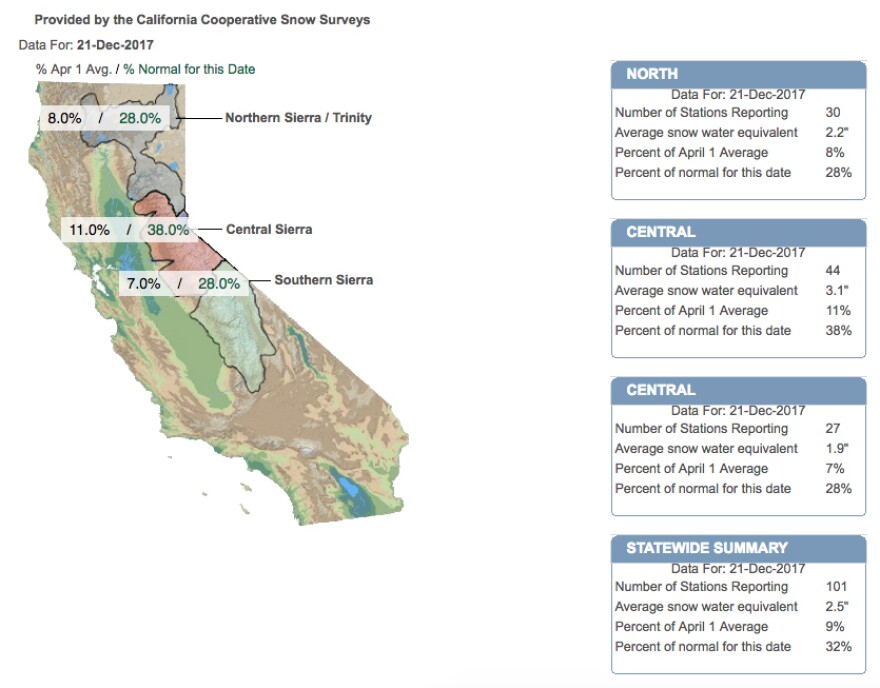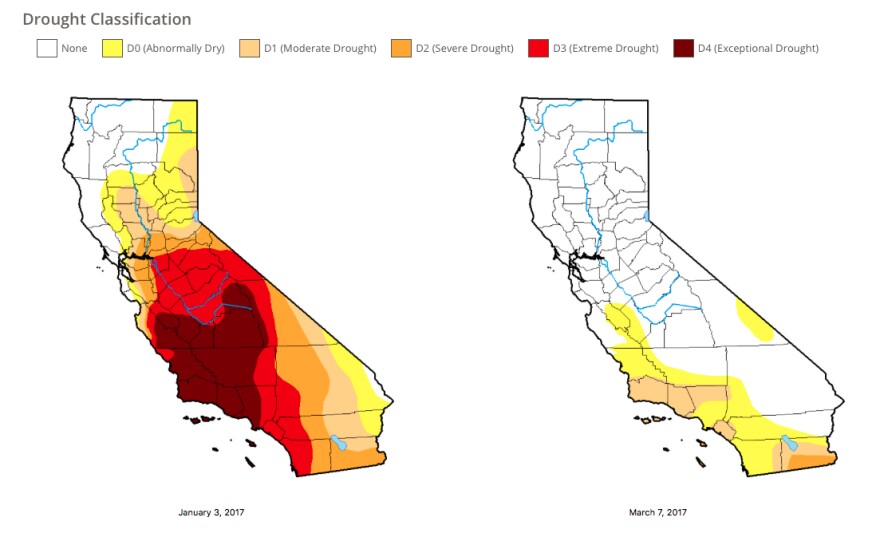Congress has cut federal funding for public media — a $3.4 million loss for LAist. We count on readers like you to protect our nonprofit newsroom. Become a monthly member and sustain local journalism.
'Year of extremes': SoCal rides climate coaster in 2017
2017 was crazy. Not necessarily in terms of politics, the economy, or your grandmother asking you to buy her bitcoin. No, in terms of Southern California's climate.
"2017 in California has really been a year of extremes," said Daniel Swain, climate scientist from UCLA. "It is consistent with the direction that a lot of climate scientists think we’re headed..."
January was a pleasant surprise
Just as 2016 came to an end, heavy rains began to alleviate the crippling drought that plagued California for nearly half a decade. It was a surprise, given that it was expected to be a dry La Niña year, and the prophesied "Monster El Niño" never materialized the year before that.
As the season progressed, our reservoirs filled, our snowpack started to build and that nagging feeling of parched desperation lifted.
By the end of February the drought was all but gone for the majority of California.
Major downpours flooded Northern California, but here in the south, we lived through a different narrative: yes, we got rain, but it wasn't enough. Los Angeles, Orange and San Bernardino counties were mostly lifted out of drought. But Ventura and Santa Barbara counties remained largely dry. Those same areas are now the location of the Thomas Fire, one of the largest wildfires in the state history.

And then along came Summer
"Recently, California has been warming faster than a lot of the rest of the United States, but in general the whole United States is still warming, just like the whole world is warming," said Swain. "The rise is pretty stark and sustained just about everywhere."
By May the rains disappeared and the hottest summer on record for California began.

SoCal – from Santa Barbara to San Diego – saw searing triple digit temperatures, but the average temperature was only the 6th hottest on record at 71.5 degrees. 1981 held on to top honors with 72.9.
Specific cities better capture the extremes experienced in different microclimates across the region. Woodland Hills – frequently the hottest spot in the San Fernando valley – saw its second hottest summer ever, with an average temperature of 78.7 degrees, just behind 79.9 in 2006.
Anaheim, home to Disneyland, saw its 4th hottest summer, and while the coastal areas were a bit cooler, Santa Barbara saw its 5th.
For Downtown L.A., this summer was the 17th hottest, but individual days set records. 98 degrees on July 8th, for instance, broke the previous record of 95 degrees in 1886.
Severe heat waves are one of the clearest signs of climate change, scientists say. And as things continue to warm,SoCal will get hotter. So much so that we might see average August temperatures in the triple digits by 2100, according to Daniel Walton from the Institute of Environment and Sustainability at UCLA.
Here are his estimates, assuming we don't curb our fossil fuel emissions.
Between May and mid-September, SoCal was also woefully dry, missing out on any precipitation until the 13th of the month.
Fall wasn't much better
Northern California saw a big storm roll through and dump a bunch of water and snow in early November, but not before Santa Rosa was destroyed by a major fire in October after a long hot and dry spell.
For us, fall has been (SURPRISE!) hot and dry. The World Series was played in 104 degree heat, the hottest ever for the event, and Downtown L.A. saw its hottest Thanksgiving on record at 92 degrees.
"The magnitude of these heatwaves has been in many cases record breaking," said Swain. "So, we sort of see a familiar pattern, but we see a magnitude that’s greater than we’ve seen in the past and that’s exactly what we’d expect to see in a warming world where heat extremes are becoming more common."
The water year, which began on October 1, has seen little to no water dropped in SoCal.
The storms earlier in the year led to growth of invasive brush across SoCal. The lack of rain and extreme heat the rest of the year dried them out. Those conditions, coupled with a myriad of other factors (including some related to climate change), led to devastating fires.
Winter is ... (maybe not) coming
Even with the heat in November, we told ourselves that we still had winter to hang our hats on; that 50 percent of our water for the year comes between December and February.
Now, we're here:
Our precipitation levels are at 0.57 percent of normal year's total. In the median year, we'd be coming up on 25 percent by now.
While the temperature's dropped in recent days, it looks like this year will be Downtown L.A.'s 5th hottest on record at about 68.3 degrees, assuming the forecast holds, according to estimates by Daniel McEvoy, Climatologist at the Western Regional Climate Center.
But for parts of the San Fernando Valley, like Woodland Hills, this year is the hottest on record at 68.5 degrees , although the data only dates back to 1949.
There's no rain expected in SoCal anytime soon. A persistent high pressure ridge sits off the west coast of North America, keeping storms from drenching us. Add to that the likelihood that this is going to be a La Niña year, and you shouldn't be surprised if things stay dry.
"Are we entering a new drought? I don’t know yet," said Michael Anderson, state climatologist with the California Department of Water Resources. "It’s something to keep an eye on though."
The snowpack in the Sierras is also far below normal.

But, as we saw earlier this year, all it takes is one or two strong storm systems to change our water future.
Is this the new normal?
Climate models suggest that California will see periods of dry (2012 - 2016 drought), punctuated by extreme downpours (January and February), followed by more dry (possibly, this winter). All the while, temperatures are expected to continue rising.
"What we’re seeing, and what we have been seeing over many decades is this sustained trend towards hotter summers and warmer years overall," said Swain. "That upward trajectory is pretty striking."
According to Swain, this swing between extremes is on track with what climate scientists expected to see in the state, as our planet continues to warm due to climate change.
As Editor-in-Chief of our newsroom, I’m extremely proud of the work our top-notch journalists are doing here at LAist. We’re doing more hard-hitting watchdog journalism than ever before — powerful reporting on the economy, elections, climate and the homelessness crisis that is making a difference in your lives. At the same time, it’s never been more difficult to maintain a paywall-free, independent news source that informs, inspires, and engages everyone.
Simply put, we cannot do this essential work without your help. Federal funding for public media has been clawed back by Congress and that means LAist has lost $3.4 million in federal funding over the next two years. So we’re asking for your help. LAist has been there for you and we’re asking you to be here for us.
We rely on donations from readers like you to stay independent, which keeps our nonprofit newsroom strong and accountable to you.
No matter where you stand on the political spectrum, press freedom is at the core of keeping our nation free and fair. And as the landscape of free press changes, LAist will remain a voice you know and trust, but the amount of reader support we receive will help determine how strong of a newsroom we are going forward to cover the important news from our community.
Please take action today to support your trusted source for local news with a donation that makes sense for your budget.
Thank you for your generous support and believing in independent news.

-
Children asked to waive right to see a judge in exchange for $2,500
-
There’s still a lot to be determined as the refinery, which supplies about one-fifth of Southern California's vehicle fuels, works to restore production and as data is collected.
-
The FCC voted to end E-Rate discounts for library hotspot lending and school bus Wi-Fi.
-
About half the Pacific Airshow’s 2025 lineup has been grounded because of the federal government shutdown.
-
USC says it’s reviewing the letter also sent to eight other prestigious schools nationwide. California's governor vowed that any California universities that sign will lose state funding.
-
Scientists say La Niña is likely, but that doesn’t necessarily mean a dry winter in Southern California.














